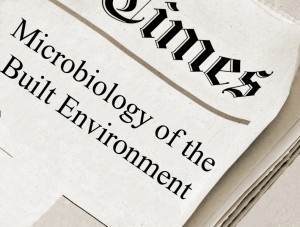Your weekly update of the literature on microbes of the built environment sensu lato. Microbes in the house Rhinitis, Ocular, Throat and Dermal Symptoms, Headache and Tiredness among Students in Schools from Johor Bahru, Malaysia: Associations with Fungal DNA and Mycotoxins in Classroom Dust – Dan Norbäck – PLOS ONE (OA) There are few studies …
New papers from the past week on the interactions between humans, buildings, and microbes. Microbes in buildings Comprehensive analysis of the skin fungal microbiota of astronauts during a half-year stay at the International Space Station – Takashi Sugita – Medical Mycology ($$) The International Space Station (ISS) is a huge manned construct located approximately 400 km …
Here are some new papers of interest. Separate treatment of hospital and urban wastewaters: A real scale comparison of effluents and their effect on microbial communities – Teofana Chonova, François Keck, Jérôme Labanowski, Bernard Montuelle, Frédéric Rimet, Agnès Bouchez – Science of the Total Environment (not OA) Hospital wastewaters (HWW) contain wider spectrum and higher quantity of pharmaceuticals …
This is the second of three posts about the planetary protection workshop I attended at NASA Ames from March 24-26, 2015. The first is here (and here.) Forward contamination, in the context of planetary protection, refers to the transport of microbes from Earth to Mars. The title of the workshop, and many talk titles refer to “human …
An important part of science is owning up to mistakes and doing the best to correct them. A couple months ago we got data from the International Space Station where we had grown up bacteria for our “Microbial Playoffs”. After analyzing the the data we blogged about the winners and disbursed the results far and …
NOTE (3-12-15): THESE RESULTS ARE INCORRECT. We have left them here for comparison. A blog post describing the problem is here and the correct information can be found here. We’ve finished analyzing all the data from the “Microbial Playoffs” part of Project MERCCURI (described here). Each microbe that was chosen to fly to the International …
The human microbiome and microbes in space are two of the sexiest topics in microbiology today. Together they have attracted the attention of the J. Craig Venter Institute. Hernan Lorenzi is leading a team to study how the composition of the human microbiome changes during long term space exploration. They will be analyzing the microbiome of …
Just a brief post here to point people to a blog post on the Science Cheerleader website which describes the efforts of our Project MERCCURI team to team up with Pop Warner to collect samples for the ISS, for the Earth Microbiome Project, and to expand the educational reach of this citizen science effort. Read …
